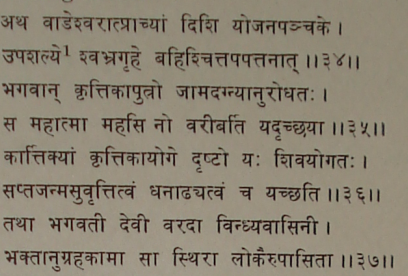|
The Indian Analyst
|
North Indian Inscriptions |
ARCHITECTURE AND SCULPTURE
eleventh canto, it has the following description of the images of Kārttikēya and Vindhyavāsinī near Chipḷuṇ in the following verses-
..
These verses mention the images of Kārttikēya and Vindhyavāsinī Dēvī in the caves
(śvabhra-gṛiha) about five yōjanas east of Chittapa-pattana (modern Chipḷuṇ). The poet did
not evidently know that the ancient name of the place was Chipulaṇa. He has imagined it
to be Chittapa-pattana, because Chipḷuṇ is well-known as the home of the Chitpāvan
(Chittapa) Brāhmaṇas. Chipḷuṇ lies at a distance of about twenty-five miles east of Guhāgara
and so answers to the description of its situation in the kāvya. A temple near the place still
has the beautifully carved images of Kārttikēya and Vindhyavāsinī Dēvī. This mention of
the images in that kāvya of A.D. 1628-29 lends colour to the inference based on stylistic grounds
that these images date back to the Śilāhāra age. [1] Read उपशैलमृ. Though this passage describes the shrine as a śvabhra-gṛiha (cave-temple), it was a small structural temple, now in ruins, The image is now preserved in the neighbouring contemporary old temple of Vindhyavāsinī Dēvī on the slope of a hill near the twin village Dhāmaṇavaṇe-Rāotaḷe, about a mile from Chipḷuṇ. See Indian Antiquary, (Third Series), p. 207.
|
|||||||||||||||||||||||||||||||||||||||||||||||||||||||||||||||||||||||||||||||||||||||||||||||||||||||||||||||||||||
| > |
|
>
|








